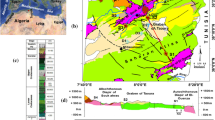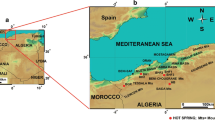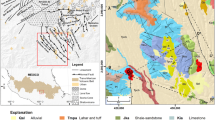Abstract
Dehydration-type mineralized waters encountered in some places of the central and eastern parts of the Polish Outer Carpathians have been studied for the first time in the light of their usefulness in estimation of thermal conditions of the geological system at regional scale. The temperature range of dehydration of mixed-layer illite/smectite clay minerals, estimated at 100–170 °C, agrees well with thermal conditions of Carpathian oil and gas generation as well as coincides with reservoir temperatures estimated by application of Mg–Li, Na–K and Na–K–Ca geothermometers, i.e. 88–160 °C, >50–112 and 79–152 °C, respectively. The discrepancy between actual temperatures at given depths calculated from geothermal gradient and those inferred from chemistry of dehydration waters (i.e. geothermometers) and geochemical processes in Carpathian geological system strongly supports the idea that the zones of origin of dehydration-type waters must be connected with deep parts of the flysch. Thermal conditions favorable for high temperature water generation occur only in deep parts of the flysch basin or even in the flysch basement. Temperatures obtained from down-hole measurements, comparable to those inferred from this study, occur at a depth greater than 3000–3500 m. Moreover, cooling down the whole geological system since the period of maximum burial diagenesis is an additional factor reducing geothermal gradient observed nowadays in this part of the Carpathian Mountains.






Similar content being viewed by others
References
Arnórsson S (1975) Application of the silica geothermometer in low temperature hydrothermal areas of Iceland. Am J Sci 275:763–784
Arnórsson S (1983) Chemical equilibria in Icelandic geothermal systems—implications for chemical geothermometry investigation. Geothermics 12:119–128
Arnórsson S (2000) Isotopic and chemical techniques in geothermal exploration, development and use: sampling methods, data handling, interpretation. International Atomic Energy Agency, Vienna, p 351
Arnórsson S, Gunnlaugsson E, Svavarsson H (1983) The chemistry of geothermal waters in Iceland. III. Chemical geothermometry in geothermal investigations. Geochim Cosmochim Acta 47:547–566
Bjørlykke K (1989) Sedimentology and petroleum geology. Springer-Verlag, Berlin Heidelberg
Boles JR, Franks SG (1979) Clay diagenesis in Wilcox sandstones of southwest Texas: implications of smectite diagenesis on sandstone cementation. J Sediment Petrol 49:55–70
Brigatti MF, Galan E, Theng BKG (2006) Structures and mineralogy of clay minerals. In: Bergaya F, Theng BKG, Lagaly G (eds) Handbook of clay science. Developments in clay science, vol 1. Elsevier, NewYork, pp 19–86
Burst JF (1969) Diagenesis of Gulf Coast clayey sediments and its possible relation to petroleum migration. Am Assoc Pet Geol Bull 53:73–93
Chowaniec J (1989) Hydrogeologiczne warunki zasilania i przepływu wód podziemnych w utworach trzeciorzędowych Podhala między Zakopanem a Białym Dunajcem. CAG PIG, Warszawa (doctoral dissertation, in Polish)
Chowaniec J (1991) Hydrogeology: Carpathian Region. In: Malinowski J (ed) Geological structure of Poland, Part VII: hydrogeology. Wydawnictwa Geologiczne, in Polish only, pp 204–215 (in Polish only)
Chowaniec J (2009) Hydrogeology study of the western part of the Polish Carpathians. Biletyn PIG 434:98
Chowaniec, J, Poprawa, D, Witek, K (2001) Occurrence of thermal waters in Polish Carpathians. Materiały IV Seminarium, Rola energii geotermalnej w zrównoważonym rozwoju, Bukowina Tatrzańska, 8–10 Październik, 2001: 89–114 (in Polish only)
Dowgiałło J (1976) Problems of the origin of Cl-HCO3-Na mineral waters of the Polish Flysch Carpathians. In: Cadek J, Paces T (eds) Proceedings of the International Symposium on Water-Rock Interaction, Czechoslovakia 1974. Geological Survey, Prague, pp 12–22
Dowgiałło, J (1980) Poligenetic model of the Carpathian chloride waters and some of its consequences. Modern Problems of Hydrogeology, Jachranka: 275–290 (in Polish only)
Dowgiałło J, Leśniak PM (1980) The origin of chloride waters in the Polish flysch Carpathians. In: Hitchon B (ed). Proceedings of the 3rd International Symposium on Water-Rock Interaction, Canada, pp 20–23
Dowgiałło J, Sławiński A (1979) Remarks on the origin of saline ground waters at Rabka (West Carpathians). In: Słowańska B, Pakulska Z (eds), Hydrogeochemistry of Mineralized Waters. Proceedings of the IAH Conference of Cieplice Spa (Poland), 1978. Instytut Geologiczny, Warszawa, pp 195–203
Dudek T, Świerczewska A (2001) Regional variation and structural control on clay diagenesis in the Polish Carpathians. In: Adam A, Szarka L, Szendoi J (eds) Book of Abstracts, Conference PANCARDI. Sopron, Hungary
Fournier RO (1977) Chemical geothermometers and mixing models for geothermal systems. Geothermics 5:41–50
Fournier RO (1979) A revised equation for the Na/K geothermometer. Geotherm Res Council Trans 3:221–224
Fournier RO, Potter RW (1979) Magnesium correction to the Na-Ka-Ca chemical geothermometer. Geochim Cosmochim Acta 43:1543–1550
Fournier RO, Rowe JJ (1966) Estimation on underground temperatures from the silica content of water from hot springs and wet-steam wells. Am J Sci 264:685–697
Fournier RO, Truesdell AH (1973) An empirical Na-Ca-K geothermometer for natural waters. Geochim Cosmochim Acta 37:1255–1275
Hower J, Eslinger EV, Hower ME, Perry EA (1976) Mechanism of burial metamorphism of argillaceous sediment: 1. Mineralogical and chemical evidence. Geol Soc Am Bull 87:725–737
Hunt JM (1979) Petroleum geochemistry and geology. W. H. Freeman and Company, San Francisco, p 617
Karnkowski P (1999) Oil and gas deposits in Poland. Geosynoptics Society “Gos”, Kraków, pp 1–380
Karnkowski P, Jarząb M (1994) Geothermal waters in Strzyżowa Depression, Carpathian Mts. Przegląd Geologiczny 42:121–123 (in Polish only)
Kharaka YK, Mariner RH (1987) Chemical geothermometers and their application to formation waters from sedimentary basins. In: Naeser ND, McCulloh TH (eds) Thermal history of sedimentary basins. Methods and case histories. Springer-Verlag, New York, pp 99–118
Kosakowski P, Więcław D, Kotarba MJ (2009) Source rock characteristic of the selected flysch deposits in the transfrontier area of the Polish Outer Carpathians. Geologia 35(4/1):155–199 (in Polish only, English abstract and summary)
Krzywina W, Sokołowski A (1977) Mineralized waters of Krosno Province. Problemy Uzdrowiskowe 5(6):81–96 (in Polish only)
Książkiewicz M (1972) Geological structure of Poland. Tectonics, Part 3: Carpathian Mts. Wydawnictwa Geologiczne, Warszawa, Vol IV, pp 121–203 (in Polish only)
Książkiewicz M (1975) Bathymetry of the Carpathian Flysch Basin. Acta Geol Pol 25(3):309–367
Kuśmierek J (ed) (1995) Evolution and hydrocarbon potential of the Polish Carpathians. Prace Geologiczne 138:9–88 (in Polish only; English summary)
Leśniak PM (1980) The origin of chloride waters at Wysowa, West Carpathians. Chemical and isotopic approach. Acta Geol Pol 30(4):519–550
Leśniak PM (1998) Origin of carbon dioxide and evolution of CO2-rich waters in the West Carpathians, Poland. Acta Geol Pol 48:343–366
Longstaffe FJ (1987) Stable isotope studies of diagenetic processes. In: Kyser TK (ed) Short course in stable isotope geochemistry of low temperature fluids, vol 13. Mineralogical Association of Canada, Saskatoon, pp 187–257
Maćkowski T, Kuśmierek J, Reicher B, Baran U, Kosakowski P, Łapinkiewicz AP, Machowski G, Papiernik B, Szczygieł M, Zając A, Zych I (2009) Two-dimensional models of the organic-matter thermal transformation and hydrocarbon expulsion in the transfrontier zone of the Polish and Ukrainian Carpathians. Geologia 35(4/1):191–222
Majorowicz J, Plewa S (1979) Study of heat flow in Poland with special regard to tectonophysical problems. In: Ćermak V, Rybach L (eds) Terrestrial Heat Flow in Europe. Springer-Verlag, Berlin, pp 240–252
Małecka D, Murzynowski W (1978) Hydrogeological zoning in Flysch Carpathians. Biblioteczka Wiadomości IMUZ 56:44–46 (in Polish only)
Morad S, Ketzer JM, De Ros LF (2000) Spatial and temporal distribution of diagenetic alterations in siliciclatsic rocks: implications for mass transfer in sedimentary basisns. Sedimentology 47:95–120
Oszczypko N, Zuber A (2002) Geological and isotopic evidence of diagenetic waters in the Polish Flysch Carpathians. Geol Carpath 53:257–268
Perry EA Jr, Hower J (1972) Late-stage dehydration in deeply buried pelitic sediments. Am Assoc Pet Geol Bull 56:2013–2021
Plewa S (1994) Distribution of geothermal parameters on the territory of Poland. CPPGSMiE PAN Press, Kraków, p 138 (in Polish, English summary)
Poprawa D (1970) Hydrogeology of Dukla folds foreland between Osława and Wetlina (with special attention to mineralized waters), Archivum PIG, Kraków, p 107 (doctoral thesis, in Polish only)
Porowski A (2001a) Temporal and spatial variability in chemical composition of mineralized waters from the Iwonicz Anticline, SE Poland. Przegląd Geologiczny 4:317–325
Porowski A (2001b) Chemical composition and origin of ionic ratios in the Iwonicz anticline mineralized groundwaters (Polish Outer Carpathians). Ann Soc Geol Pol 71:125–134
Porowski A (2001c) Chemical indicators of the origin of mineralized waters in the Central Carpathian Synclinorium. In: Bocheńska T, Staśko S, Wąsik M (eds) Modern problems of hydrogeology X (1), Wrocław, pp 397–404
Porowski A (2004a) Isotopic evidence of the origin of mineralized waters from the Central Carpathian Synclinorium, SE Poland. Environ Geol 46:661–669
Porowski A (2004b) Origin of mineralized waters in the Central Carpathian Synclinorium. ING PAN, p 195 (doctoral thesis, in Polish only; unpublished)
Porowski A (2006) Origin of mineralized waters in the Central Carpathian Synclinorium, SE Poland. Studia Geologica Polonica 125:67
Powers MC (1967) Fluid-release mechanisms in compacting marine mudrocks and their importance in oil exploration. Am Assoc Pet Geol Bull 51:1240–1254
Różański K, Araguas-Araguas L, Gonfiantini R (1993) Isotopic patterns in modern global precipitation. In: Stewart PK, Lohmann KC, McKenzie J, Savin S (eds) Climate change in continental isotopic records. Geophys Monograph 76:1–36
Sheppard SMF (1986) Characterization and isotopic variations in natural waters. In: Valley JW, Taylor HP Jr, O’Neil JR (eds). Stable isotopes in high temperature geological processes. Reviews in Mineralogy 16: 165–183
Ślączka A (1977) Remarks on the geological structure of the Krosno Province. In: Ślączka A (ed) Guide to XLIX Meeting of Polish Geological Society. Wydawnictwa Geologiczne, Warszawa, pp 7–32 (in Polish only)
Ślączka A, Kruglov S, Golonka J, Oszczypko N, Popadyuk I (2005) The general geology of the Outer Carpathians, Poland, Slovakia, and Ukraine. In: Picha F, Golonka J (ed) The Carpathians and their foreland: Geology and hydrocarbon resources: American Association of Petroleum Geologists Memoir 84: 221–258
Sokołowski J, Sokołowska J, Plewa S, Nagy S, Krotoszyńska M, Krzysiek U (1995) Geothermal provinces and basins of Poland. PGA and PAS, Kraków, Poland: p 122 (in Polish only)
Środoń J (1999) Nature of mixed-layer clays and mechanisms of their formation and alteration. Annu Rev Earth Planet Sci 27:19–53
Środoń J (2007) Illitization of smectite and history of sedimentary basins. EUROCLAY, APA, Aveiro, pp 74–82
Środoń J, Eberl DD, Drits VA (2000) Evolution of fundamental particle-size during illitization of smectite and implications for reaction mechanism. Clays Clay Miner 48:446–458
Świerczewska A (2005) The interplay of the thermal and structural histories of the Magura Nappe (Outer Carpathians) in Poland and Slovakia. Mineralogia Polonica 36:91–144
Szewczyk J, Gientka D (2009) Terrestrial heat flow density in Poland—a new approach. Geol Quart 53:125–140
Taylor BE (1987) Stable isotope geochemistry of ore forming fluids. In: Kyser TK (ed) Short course in stable isotope geochemistry of low temperature fluids, vol 13. Mineralogical Association of Canada, Saskatoon, pp 337–445
Yeh HW (1980) D/H ratios and late-stage of dehydration of shales during burial. Geochim Cosmochim Acta 44:341–352
Yeh HW, Savin SM (1977) Mechanizm of burial metamorphism of argillaceous sediments: 3. O-isotope evidence. Geol Soc Am Bull 88:1321–1330
Zuber A, Chowaniec J (2009) Diagenetic and other highly mineralized waters in the Polish Carpathians. Appl Geochem 24:1889–1900
Zuber A, Grabczak J (1985) The origin of some mineral groundwaters of Poland in the light of up-to-date isotopic studies. Modern Problems of Hydrogeology. Proceedings of the 3rd National Symposium, Wydawnictwo Akademii Górniczo—Hutniczej, Kraków, pp 135–148 (in Polish only)
Zuber A, Grabczak J (1986) Determining the origin of mineral waters in southern Poland with the aid of isotope methods. Freib Forsch 417:116–126
Zuber A, Grabczak J (1987) On the origin of chloride waters in the Flysh Carpathians—continuation of the discussion. Przegląd Geologiczny 7:366–372
Zuber A, Chowaniec J, Borowiec M (2010) On the origin of chloride waters in the Polish Flysch Carpathians. Biuletyn PIG 441:21–28
Żytko K (ed) (2004) Profiles of deep boreholes of Polish Geological Institute, vol. 103: Jasień IG 1. PIG, Warszawa, p 69 (in Polish only)
Żytko K (ed) (2006) Profiles of deep boreholes of Polish Geological Institute, vol. 107: Brzegi Dolne IG 1. PIG, Warszawa, p 53 (in Polish only)
Author information
Authors and Affiliations
Corresponding author
Rights and permissions
About this article
Cite this article
Porowski, A. Geothermometric and isotopic studies of dehydration waters: implications for thermal conditions in the Central Carpathian Synclinorium, SE Poland. Environ Earth Sci 74, 7539–7553 (2015). https://doi.org/10.1007/s12665-015-4631-0
Received:
Accepted:
Published:
Issue Date:
DOI: https://doi.org/10.1007/s12665-015-4631-0




